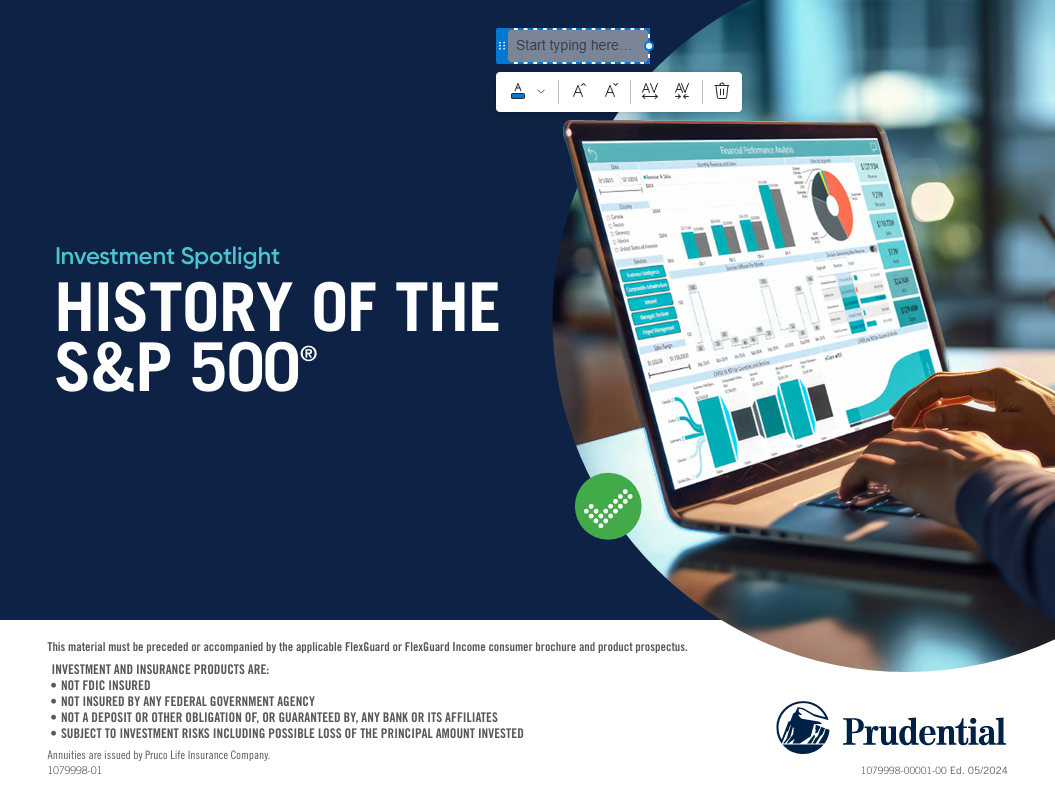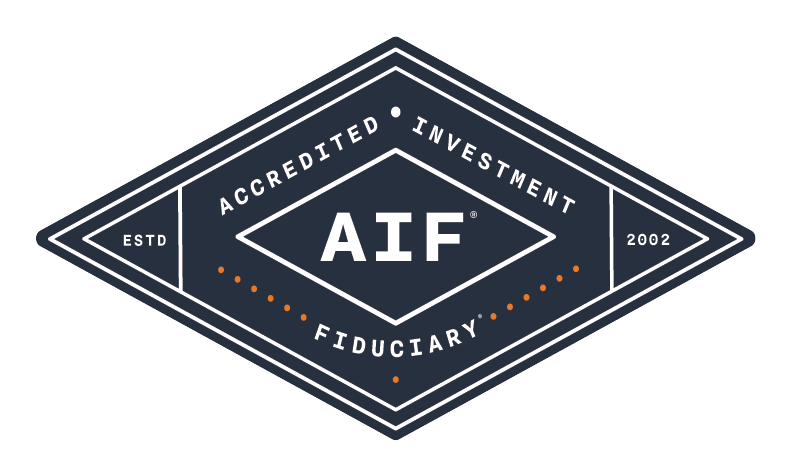Average 401(k) Balance by Age in 2024
Benchmarking Your Retirement Savings
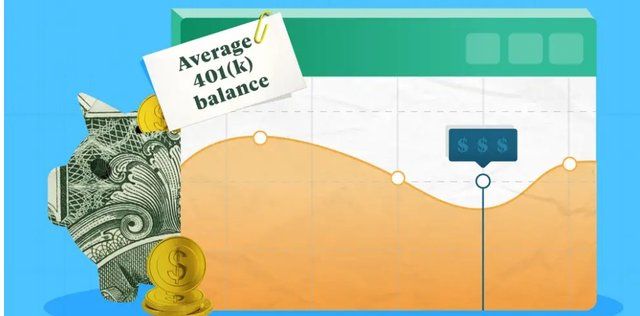
Article by Business Insider: Tessa Campbell and Paul Kim. July 30, 2024
A 401(k) account is an employee-sponsored retirement vehicle that allows you to contribute pre-tax income toward your retirement. As one of the best retirement plans for US employees, a 401(k) lets you reduce the amount of income you're taxed on and lets your funds grow tax-free.
Every year, Vanguard analyzes account data from millions of retirement accounts in a report titled "How America Saves."
Knowing the average 401(k) balance by age group and income level can help you determine how much you need to retire. Here's the average 401(k) account balance based on age in 2024.
Understanding the average 401(k) balance in 2024
According to Vanguard's annual data report, the average 401(k) account balance in 2024 was $134,128, an increase from 2023's average balance of $112,572.
Across these accounts, the typical account balances vary widely by the method used to calculate it — while the average 401(k) savings balance is well over $100,000, the median account balance is much less at $35,286, according to Vanguard's latest data.
The Vanguard data is broken down by demographics, showing a wide range of average account balances across various age ranges, income levels, industries, and genders. Here's a breakdown of those balances.
Average 401(k) balance by age
Retirement savings grow with compound interest, which means account balances increase with time. Like other types of retirement accounts, money saved in a 401(k) grows like a snowball, with interest earning interest on itself. The older you are, the more time you've had to build up your savings.
With compounding interest, the earlier money is put into an account, the more opportunity it has to grow and the greater the possible returns. In retirement accounts like 401(k)s, building retirement savings early means a greater opportunity for growth.
In 2024, employees can contribute up to $23,000 in their traditional and Roth 401(k). Folks aged 50 or older can contribute an additional catch-up contribution of $7,500 in 2024.
According to Vanguard, here's the average amount people have saved for retirement by age group.
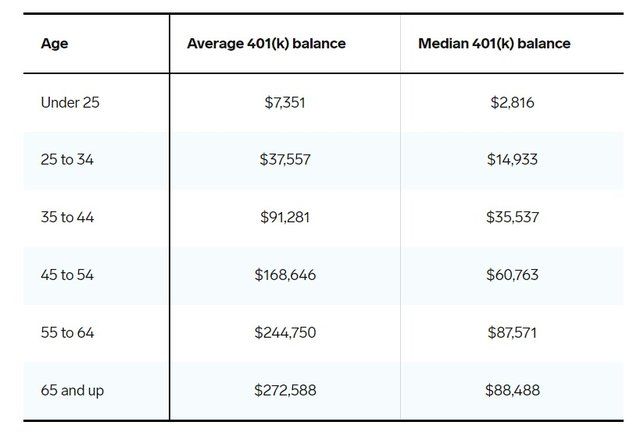
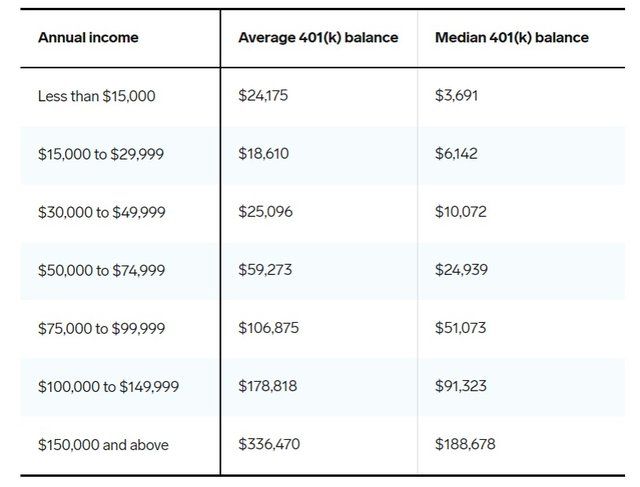
Here's the annual income compared against the average 401(k) balance and median 401(k) balance:
Average 401(k) balance between men and women
On average, men save more for retirement than women.
Across all age levels, Vanguard's data indicates that women have a median 401(k) account balance of just over $11,099 less than men's.
A 2023 report from the Bureau of Labor Statistics shows that the average woman makes around 86 cents for every man's dollar, which affects how much women can put away for retirement.
While a large disparity in savings exists, women often need greater retirement savings than men to retire comfortably. Women tend to live longer and, therefore, need more long-term care than men, which could require greater spending in retirement.
Average 401(k) balance by industry
Balances also vary widely among industries. One possible explanation is that employer match benefits, in which an employer matches an employee's contributions to their savings up to a given percentage, may be more common in some industries than others. Earnings could also affect how workers in a specific industry save.
Here's how the average balances break down by industry.
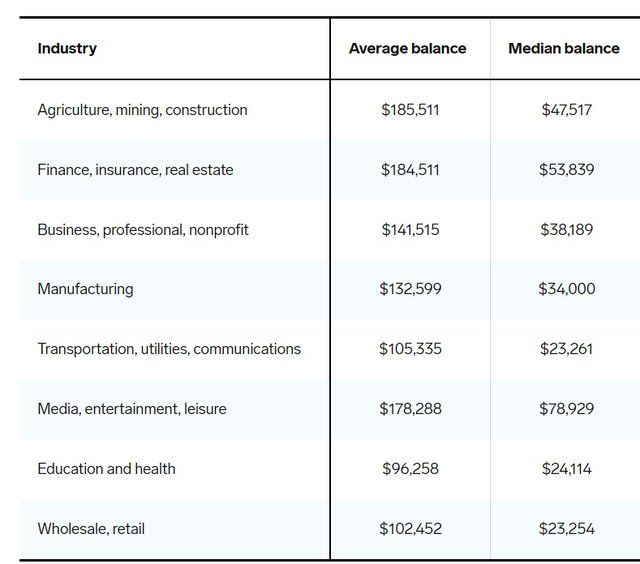
People who work in agriculture, mining, and construction contribute significantly to retirement, with the average industry worker's account balance well over $180,000. However, teachers, healthcare workers, and people who work in wholesale and retail tend to lag behind, with average account balances under $97,000.
Enhancing your 401(k): Strategies for success
1. Start early, contribute often
Time is a crucial part of financial planning for retirement. Contributing money toward retirement savings allows compound interest to work magic and combat inflation. Even modest contributions can grow into significant savings over time when deposited regularly.
Ideally, you'll be able to contribute more as your salary increases and your financial situation improves. However, ensure not to over-contribute and lose access to money you'll need shortly. Setting aside cash in an emergency fund is a great way to avoid a 401(k) early withdrawal before your 59 1/2.
2. Take advantage of employer-match benefits
A common benefit with 401(k)s is an employer match benefit, and it's essentially free money. Employers can match a dollar-for-dollar or partial match of an employee's retirement saving contributions. If you can swing it, contribute enough to unlock your employer's full contribution amount and hit your retirement saving benchmarks.
Under the Secure 2.0 Act, employers can now offer a student loan match to their employees' retirement savings plans when they make qualifying student loan payments.
Quick tip: Vesting signifies that an employee has fulfilled specific criteria to claim ownership over a designated portion of their retirement savings. This may take up to three to five years. Employers may also contribute a matching amount to an employee's yearly savings (up to a predetermined limit). Once an employee reaches a 100% vested status, they possess complete ownership of the accumulated funds in their 401(k) or similar retirement plan.
3. Diversify investments
Diversifying your investment is key to managing risk and volatility in your portfolio. Investment diversification in a 401(k) may also boost growth by getting exposure across multiple market sectors and different kinds of assets.
You can easily diversify your investment portfolio by investing in different stocks, bonds, ETFs, mutual funds, and alternative investment options like real-estate and commodities.
4. Mind the fees
High management fees can erode your savings over time. Pay attention to the fee schedules and manage 401(k) fees in your plan by investing in low-cost funds like ETFs. If you have an old employer's 401(k) plan, consider rolling over the assets into a new IRA because IRAs vs 401(k)s offer lower fees and more investment opportunities.
5. Regular rebalancing
As the market fluctuates, so will the composition of your investment portfolio. Your age and proximity to retirement also influence how your portfolio should be allocated. Regular rebalancing is key to keeping your investments on track and maximizing your 401(k) contributions to reach your goals and stay aligned with your risk tolerance.
Average 401(k) balance FAQs
How much should you save in 401(k) by age?
How much you should save in your 401(k) varies by age. You should aim to save 1x your annual salary by 30, 3x by age 40, 6x by age 50, and 8x by age 60. The best way to reach these age markers is by starting early, consistently contributing, and adjusting based on income, lifestyle, and retirement goals to ensure financial security.
How much do most people have in 401(k)?
The average 401(k) balance varies by age. Generally, individuals under age 25 have around $7,000 in retirement savings, and individuals between 25 and 34 have around $37,000 in retirement savings. People aged 55 and 64 have around $244,000.
Your 401(k) is your future
A 401(k), 403(b), or other retirement plan is more than a savings account. Retirement savings plans are a wealth-building tool to ensure a comfortable, secure, and stress-free retirement. By understanding how age, income, and gender impact your retirement savings, you can make better-informed decisions that align with your demographic and investment goals.
But you'll need a well-thought-out financial plan before you can reap the rewards of your retirement savings. Consult a financial expert like a fiduciary or CFP for professional management and guidance.
This Business Insider article was legally licensed by AdvisorStream
Securities and investment advisory services are offered through Osaic Wealth, Inc., broker-dealer, registered investment adviser and member of FINRA and SIPC.
Osaic Wealth, Inc. is separately owned and other entities and/or marketing names, products or services referenced here are independent of Osaic Wealth, Inc.









